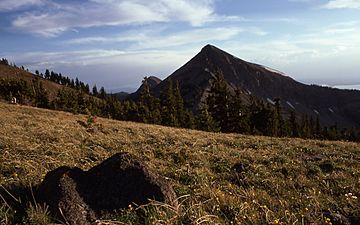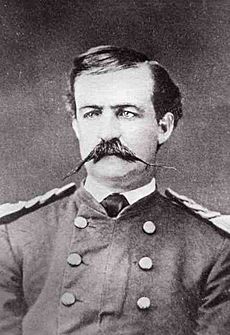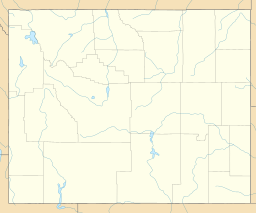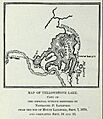Mount Doane facts for kids
Quick facts for kids Mount Doane |
|
|---|---|

Mount Doane, Yellowstone National Park, Wyoming, 1977
|
|
| Highest point | |
| Elevation | 10,551 ft (3,216 m) |
| Geography | |
| Parent range | Absaroka Range |
| Topo map | Sylvan Lake |
Mount Doane is a tall mountain peak in the Absaroka Range. It is located inside Yellowstone National Park in Wyoming. This mountain stands at about 10,551 feet (3,216 meters) high.
The mountain is named after Lieutenant Gustavus Cheyney Doane. He was an officer in the U.S. Army cavalry. Doane helped guide an important trip into Yellowstone in 1870. This trip was called the Washburn-Langford-Doane Expedition.
Exploring Yellowstone: The Washburn-Langford-Doane Expedition
Gustavus Cheyney Doane was a key part of the Washburn-Langford-Doane Expedition in 1870. During this trip, Doane and another explorer, Nathaniel P. Langford, climbed several peaks. These peaks were located east of Yellowstone Lake.
The leader of the expedition, Henry D. Washburn, first named a different peak after Doane. However, that peak's name was later changed to Mount Schurz.
Mount Doane got its official name in 1871. This happened during the Hayden Geological Survey of 1871. The survey wanted to honor Doane for his important report. This report was the first official exploration account of the Yellowstone area. Doane also joined the first Hayden expedition in 1871.

Doane wrote about his climb with Langford into the Absaroka Range. He described the amazing views from the top. He wrote about seeing Yellowstone Lake and sketching its shape. He also saw other mountains and valleys. Doane noted many lakes and streams in the area.
Proposals to Rename Mount Doane
In recent years, some groups have suggested changing the name of Mount Doane. These groups are mainly Native American organizations. They proposed renaming it "First Peoples Mountain."
They believe that Gustavus Doane should not be honored with a mountain name. This is because of his involvement in a difficult historical event. This event was known as the Marias Massacre. During this event, many Native American people died. Some groups feel that Doane's actions during this time make him unsuitable for such an honor.
Images for kids
-
Mount Doane (left) and Mount Stevenson (right) 1871




